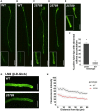Hydroxyproline- O-Galactosyltransferases Synthesizing Type II Arabinogalactans Are Essential for Male Gametophytic Development in Arabidopsis
- PMID: 35774810
- PMCID: PMC9237623
- DOI: 10.3389/fpls.2022.935413
Hydroxyproline- O-Galactosyltransferases Synthesizing Type II Arabinogalactans Are Essential for Male Gametophytic Development in Arabidopsis
Abstract
In flowering plants, male reproductive function is determined by successful development and performance of stamens, pollen grains, and pollen tubes. Despite the crucial role of highly glycosylated arabinogalactan-proteins (AGPs) in male gamete formation, pollen grain, and pollen tube cell walls, the underlying mechanisms defining these functions of AGPs have remained elusive. Eight partially redundant Hyp-galactosyltransferases (named GALT2-GALT9) genes/enzymes are known to initiate Hyp-O-galactosylation for Hyp-arabinogalactan (AG) production in Arabidopsis thaliana. To assess the contributions of these Hyp-AGs to male reproductive function, we used a galt2galt5galt7galt8galt9 quintuple Hyp-GALT mutant for this study. Both anther size and pollen viability were compromised in the quintuple mutants. Defects in male gametogenesis were observed in later stages of maturing microspores after meiosis, accompanied by membrane blebbing and numerous lytic vacuoles. Cytological and ultramicroscopic observations revealed that pollen exine reticulate architecture and intine layer development were affected such that non-viable collapsed mature pollen grains were produced, which were devoid of cell content and nuclei, with virtually no intine. AGP immunolabeling demonstrated alterations in cell wall architecture of the anther, pollen grains, and pollen tube. Specifically, the LM2 monoclonal antibody (which recognized β-GlcA epitopes on AGPs) showed a weak signal for the endothecium, microspores, and pollen tube apex. Pollen tube tips also displayed excessive callose deposition. Interestingly, expression patterns of pollen-specific AGPs, namely AGP6, AGP11, AGP23, and AGP40, were determined to be higher in the quintuple mutants. Taken together, our data illustrate the importance of type-II AGs in male reproductive function for successful fertilization.
Keywords: arabinogalactan-proteins; exine; hydroxyproline-galactosyltransferases; intine; microgametogenesis; pollen grains; pollen tube.
Copyright © 2022 Kaur, Moreira, Coimbra and Showalter.
Conflict of interest statement
The authors declare that the research was conducted in the absence of any commercial or financial relationships that could be construed as a potential conflict of interest.
Figures









Similar articles
-
A review on the function of arabinogalactan-proteins during pollen grain development.Plant Reprod. 2025 Feb 6;38(1):8. doi: 10.1007/s00497-024-00515-9. Plant Reprod. 2025. PMID: 39912945 Free PMC article. Review.
-
Functional characterization of hydroxyproline-O-galactosyltransferases for Arabidopsis arabinogalactan-protein synthesis.BMC Plant Biol. 2021 Dec 13;21(1):590. doi: 10.1186/s12870-021-03362-2. BMC Plant Biol. 2021. PMID: 34903166 Free PMC article.
-
Knockout of eight hydroxyproline-O-galactosyltransferases cause multiple vegetative and reproductive growth defects.Cell Surf. 2023 Nov 25;10:100117. doi: 10.1016/j.tcsw.2023.100117. eCollection 2023 Dec 15. Cell Surf. 2023. PMID: 38076635 Free PMC article.
-
Eight hydroxyproline-O-galactosyltransferases play essential roles in female reproductive development.Plant Sci. 2024 Nov;348:112231. doi: 10.1016/j.plantsci.2024.112231. Epub 2024 Aug 21. Plant Sci. 2024. PMID: 39154893
-
Formation pattern and regulatory mechanisms of pollen wall in Arabidopsis.J Plant Physiol. 2021 May;260:153388. doi: 10.1016/j.jplph.2021.153388. Epub 2021 Feb 12. J Plant Physiol. 2021. PMID: 33706055 Review.
Cited by
-
New insights on the expression patterns of specific Arabinogalactan proteins in reproductive tissues of Arabidopsis thaliana.Front Plant Sci. 2022 Dec 2;13:1083098. doi: 10.3389/fpls.2022.1083098. eCollection 2022. Front Plant Sci. 2022. PMID: 36531351 Free PMC article.
-
A review on the function of arabinogalactan-proteins during pollen grain development.Plant Reprod. 2025 Feb 6;38(1):8. doi: 10.1007/s00497-024-00515-9. Plant Reprod. 2025. PMID: 39912945 Free PMC article. Review.
-
AtFH5 recruits and transports the arabinogalactan protein AGP23 to maintain the tip growth of pollen tube.Proc Natl Acad Sci U S A. 2024 Dec 3;121(49):e2410607121. doi: 10.1073/pnas.2410607121. Epub 2024 Nov 25. Proc Natl Acad Sci U S A. 2024. PMID: 39585983 Free PMC article.
-
Cell Wall Microdomains in the External Glands of Utricularia dichotoma Traps.Int J Mol Sci. 2024 May 31;25(11):6089. doi: 10.3390/ijms25116089. Int J Mol Sci. 2024. PMID: 38892273 Free PMC article.
-
OsAPSE modulates non-covalent interactions between arabinogalactan protein O-glycans and pectin in rice cell walls.Front Plant Sci. 2025 May 22;16:1588802. doi: 10.3389/fpls.2025.1588802. eCollection 2025. Front Plant Sci. 2025. PMID: 40475901 Free PMC article.
References
-
- Basu D., Tian L., Wang W., Bobbs S., Herock H., Travers A., et al. (2015a). A small multigene hydroxyproline-O-galactosyltransferase family functions in arabinogalactan-protein glycosylation, growth and development in Arabidopsis. BMC Plant Biol. 15:295. 10.1186/s12870-015-0670-7 - DOI - PMC - PubMed
LinkOut - more resources
Full Text Sources
Molecular Biology Databases
Miscellaneous

